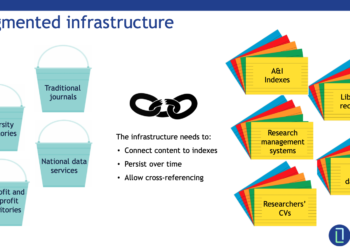The acquisition this week of protocols.io by Springer Nature brought to mind this 2019 post (along with Joe Esposito’s 2015 post “When is a Feature a Product, and a Product a Business?“). Although protocols.io was technically a for-profit entity (more of a profit-for-purpose entity), much of the analysis below on the struggles of open, community-run infrastructure are relevant. protocols.io had a good ten-year run, but despite repeated investment by funders and others, never achieved a sustainable business model that permitted stability. And so it is now part of the Springer Nature stable of methods products, an impressive array that may be poised to dominate the next phases of open research.
We are beginning to see the first practical implementations of open source tools, steps toward the research community attempting to reclaim scholarly communications from the commercial interests which have dominated it for the last half century or so. Community-led projects have taken on an increased urgency after the recent spate of acquisitions of essential infrastructure by commercial interests (bepress, as one example, is now a cog in Elsevier’s research workflow strategy). The goals here are both laudable and achievable, but when we think about scholarly communications, we must take the long-term view. Our strategies must be aimed toward permanence and preservation – of systems that will be self-sustaining and stand the test of time — rather than just hoping more support will come along once the initial grant runs out. Are there ways we can help these efforts succeed?
Over the last decade, a clear picture has emerged from the research community. What they want from their system of scholarly communications includes openness, transparency, and expanded access to research outputs including, but not limited to, the final published paper. The drive toward open infrastructure is meant to level the playing field and do away with lock-in to any individual company. What remains unclear is how to make these things happen and who is going to pay for them. Library budgets are already strained to the limit, funders don’t seem to be offering large increases in financial support, and researchers are objecting to seeing their research funds diverted to paying publishing costs.

In a superb piece of analysis, Katherine Skinner, Executive Director of Educopia, took a deep dive into the question of why so many scholarly communication projects stagnate or fizzle out entirely. Her conclusions are largely drawn from Educopia’s recent report Mapping the Scholarly Communication Landscape 2019 Census. If you’re pressed for time, I would advise you stop here and read Skinner’s article instead. In fact, read it twice, as it is both insightful and information dense, with much to consider and digest. I won’t go into every one of her cogent points, but wanted to highlight a few that really resonated with my experience in publishing and community infrastructure efforts.
The first is the emphasis on novelty and innovation at the expense of maintenance. If you have a good idea, it’s not that hard to get a grant or financial backing to build out that idea, but once it exists, how do you keep it running? There’s not a lot of funding out there for long term maintenance (and by maintenance, I mean continuous updating and upgrading) of existing services or tools. As Skinner explains:
The tools, platforms, and services that get attention tend to be the buzzy ones with new bells and whistles, not the stable ones who are maintaining their foundation…Most grants are for entirely new development directions, and often all of the staff are paid to pursue that new direction. The vital work of maintenance happens on the margins of paid time and in unpaid overtime.
The way to overcome this problem is to build in a business model from the very beginning of the project. Relying on grants, donations, or membership dues is an unstable foundation for a project meant to stand the test of time. A change in government, an economic downturn, or a shift in priorities for your key members can be the undoing of a valuable piece of infrastructure that is reliant upon the goodwill of donors.
Instead, approaching not-for-profit, community-owned projects as businesses can provide a solid basis for their continuing existence. As always, it’s important to understand that not-for-profits must generate a surplus if they hope to be around for long. Breaking even leaves you no ability to grow, improve your offerings, weather a difficult period, or overcome strategic mistakes. While you don’t need to profit at the levels seen by commercial entities in the community, you can charge fair prices for valued services and earn enough to run a successful and continuing organization.
Consider CrossRef as an example. CrossRef runs at a reasonable profit margin, consistently earning a significant surplus every year. This both ensures the continuing presence of the essential services CrossRef offers to the community, and it allows them to continually improve those services and build out new projects for the benefit of the community.
There’s a second key point in that quote above, the mention of “unpaid overtime”:
In part because academy-owned solutions charge less, they often require more engagement from their “client-members.” Burn out is a serious threat to stability, and it’s happening to our leaders, our advocates, and our volunteers.
Relying on volunteers working in their spare time is not a reliable basis for essential infrastructure. Expecting volunteers working at night and on weekends to outcompete commercial products with highly paid professionals puts community efforts at an immediate disadvantage. Beyond the inefficiencies and instability, there are labor ethics issues here. With core values of openness and equitability, labor practices need to be similarly transparent and fair. There is a clear value to living wages as an aspect of the sustainable future, and that means a business model that allows you to pay talented workers what they are worth.
Another key point in Skinner’s analysis is the lack of business experience and knowledge in community-led projects:
Most of our programs and organizations are led by founders or champions who know a lot about the product or service, but who have never been taught how to build or maintain a business.
Academics often have a bias against business – it’s a foreign world, outside of their expertise or interest. As someone who has gone from the laboratory bench to a career in the publishing business, I can readily testify that business is hard to learn. It took me a similar amount of time to start to feel comfortable with the tools and concepts of the laboratory as it did the tools and concepts of running a book or journal publishing program. It’s not enough to just have a really good idea, or, as Joe Esposito puts it, “there is more to the game than being smart.“
There is a balance to be had between idealism and pragmatism, of finding practical ways to realize lofty goals. The two largest and most successful university presses, Oxford and Cambridge, have built that success on being run as businesses, on a separate management track than their parent universities. PLOS is another example of success where an ideologically-driven not-for-profit has succeeded by hiring smart, experienced business people to build and run the operations.
The challenge then, is to bring business acumen and experience to community-owned projects. This can be difficult because the consultants and executives who know this stuff really well are often far too expensive for a small not-for-profit research society or academic library-led project to afford. As a potential solution, Skinner points to groups like the Nonprofit Finance Fund as a way forward. The NFF is a 501(c)(3) that offers financing, consulting, partnerships, and knowledge-sharing for not-for-profits.
Is there capacity to create similar shared resources for the scholarly research community? If the community hopes to wrangle back control over its communication system from the commercial sphere, then building programs to provide business experience and acumen may be one of the most essential types of infrastructure needed for success. There are reasons why the commercial companies dominate the landscape — they’re really very good at what they do. But these are skills, practices, and strategies that can be learned and readily applied to not-for-profit approaches. If we want to build community infrastructure that can thrive over the long term rather than struggle with a hand-to-mouth existence, then a sound business foundation is essential.
Discussion
3 Thoughts on "Revisiting — Building for the Long Term: Why Business Strategies are Needed for Community-Owned Infrastructure"
I agree with everything except one sentence: “The way to overcome this problem is to build in a business model from the very beginning of the project.”
I think it is important to have *some idea* of potential business models from the start, and very important to have a path to transition to a business model during the grant fallow period between shiny-new-thing and essential infrastructure.
But, for me, having some idea of a business model and “building in a business model” are different. If the expectations for sustainability are high at the outset, then infrastructure developers will be too afraid to fail. This will reduce risk-taking on innovative possibilities and reduce willingness to stop investing in projects that aren’t meeting their aspirations.
Lots of ideas are worth trying, few are worth sustaining. It is important to improve the process for achieving sustainability for open infrastructures, and to enable (even celebrate) graceful ending of promising ideas that didn’t work out. The solution, I think, should focus more on (a) assessing whether new projects have any viable path to sustainability to avoid inevitable failure, and (b) increasing support mechanisms for transitioning projects that demonstrate success to sustainable business models.
Wow throwing stones in a glass house?
“Relying on volunteers working in their spare time is not a reliable basis for essential infrastructure. … Beyond the inefficiencies and instability, there are labor ethics issues here. With core values of openness and equitability, labor practices need to be similarly transparent and fair.”
This and the following paragraph is an interesting argument against essential open infrastructure coming from an industry that relies on volunteer effort for its very existence!
When was the last time I was paid to review or edit…? Never, ok I and the rest of the academy are volunteers. We have given our time freely to large for profit publishers, who are raking in 37% profit margins, far higher than google and apple (https://infrastructure.sparcopen.org/landscape-analysis/elsevier).
The point that is being made is fair, volunteers do get burned out yet the argument rings hollow that this is a distinguishing or a negative feature of academic infrastructure, when for profit publishers, and societies have relied on this same type of effort for many decades. We might argue that many in the academy would rather give their volunteer effort to academic infrastructures as opposed to for profit companies.
That’s an interesting comparison. What we think of as “peer review” came about in the 1970s, a period where the time demands on researchers were quite different than they are now (https://scholarlykitchen.sspnet.org/2018/09/26/the-rise-of-peer-review-melinda-baldwin-on-the-history-of-refereeing-at-scientific-journals-and-funding-bodies/). As you note, the practice has been more long-lived than most volunteer-reliant activities, but is indeed wearing thin. If you were to start from scratch and build a new system for the research literature, would you continue this practice or instead follow the suggestions in the post? As for paying reviewers, this post is worth consideration:
https://scholarlykitchen.sspnet.org/2021/06/16/whats-wrong-with-paying-for-peer-review/



